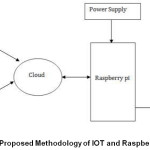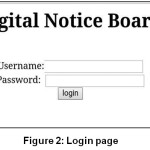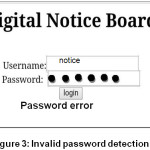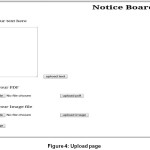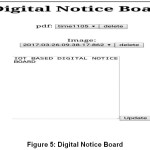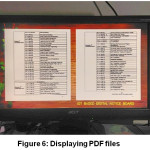Introduction
Notice board is an essential information gathering system in our life. In our day-to-day life, we can see notice boards in various places like educational institutions, railway stations, shopping malls, Bus stations, offices etc. So we can say that Notice boards are the places to leave public information such as advertise events, announce events or provide attention to the public, etc. Nowadays a Separate person is needed to stick that information on the notice board. It will lead to loss of time as well as usage of manpower. In conventional analogue type notice boards paper is the main medium for information exchange. We know that information counts are endless. So there is a usage of a huge amount of paper for displaying those endless counts of the information.
The problems faced by the wooden or conventional type notice boards are resolved by the implementation of our digital notice board. It will bring an advanced means of passing notices around in the world in a much easier and efficient way. Due to the popularity of the internet, we choose the internet as a medium for transferring information. The Internet of things (IoT) is the network of physical devices, vehicles, home appliances and other items embedded with electronics. Software, which enables these objects to connect and exchange data. Each device is uniquely identifiable through its Embedded computing system but is able to interoperate within the existing Internet infrastructure For providing security, we add username and password type authentication system. So only respective authority can send information. Raspberry Pi which is the Heart of our system. A monitor is interfaced with Raspberry Pi. So the information in the form of text, image and pdf can display on the large screens. Our primary aim is to get more people’s attention on the display. By the usage of high definition display devices, people can get more attention on the notice board rather than conventional notice boards.0 In conventional wireless notice board can display only texted messages. But in our newly implemented system can display images and pdf documents in addition to text messages. Because in Educational institutions the majority of information given from the higher authorities in the form of images or pdf format. So displaying these types of information make our system more user-friendly. Due to the utilization of the internet, the sender can send a message anywhere in the world. There is no range limitation for the successful exchange of information.
Literature Survey
In early days GSM technology is used for displaying information.1 Here GSM module which is located at digital notice board is used to receive information from the authorized user and displayed. In this work, the only text message is transferred. It becomes inefficient when we need to transfer other than text messages. By introducing the concept of Bluetooth technology2 communications become faster and efficient. Here an android application is used for enabling Bluetooth for sending a message. This work mainly focused on cable replacement and data can send up to the rate of 1 Mb per sec. Bluetooth has a limited range (approximately 70m to 100 m).In order to increase the range of communication Zigbee based notice boards are introduced3 But here data rate is only about 250 Kb per sec. Wi-Fi-based digital notice boards are currently used in many places like schools, colleges, railway stations, Airports etc. Here Raspberry pi which acts as a receiver and it connected with local Wi-Fi networks. When a person wants to send information to the raspberry pi, the person first connected to corresponding Wi-Fi. So sender and receiver must be within the Wi-Fi range. The maximum possible range of Wi-Fi is about 100 meter. Due to this range, information exchange must be done within the boundaries.
Design Rationale
Achieving the following criteria is the main designing goal for the architecture of the proposed system.
Reduction of manpower: Reduction in the effort of a separate person, who has stick notices manually on the conventional notice board.
Reduction in time: The facilities in the high-speed internet, the peoples can view transmitted information on the display board within seconds. There is less waiting time for accessing the information.
Ease inaccessibility: Here notice information is accessed through the internet, so there will be widespread of the information over a wide region. Also, the internet will give access to its respective nodes connected to its server and hence accessibility becomes easy.
An improvement over technology: The sender and receiver are connected with each other with the help of internet. Thus it will enable communication over a wide range without any physical connections between them.
Reduction in the size of the system: Only Raspberry Pi is used for achieving the overall performance of the system. This single hardware makes a reduction in the system.
Proposed System
Overview
The figure above shows the Block diagram for the proposed system. The main objective of the system is to develop a wireless notice board that displays notices in the form of image, text, pdf. It uses a Raspberry Pi as a processor. Raspberry Pi is equipped with a Portable Projector/LCD display. We can display messages and can be easily set or changed from anywhere in the world. In addition, the mobile application is used to convert voice into text. Here the voice is passed through the voice reorganization system and converted into text. The system will send this message to the cloud. Then it passes to the notice board which is connected to the internet by Wi-Fi. The processor, process it and displayed on the screen. We can send the message to all the screens or the desired screen.
Methodology
The main function of the proposed system is to develop a Digital notice board that display message sent from the user through internet and to design a simple, user friendly system, which can receive and display notice in a particular manner with respect to date and time which will help the user to easily keep the track of notice board every day and each time he uses the system. The system consists of two sections called as sender and receiver, which shown in figure 1. The sender is responsible for sending valuable information through the wireless network. In order to access Digital notice board, the sender must enter into the corresponding web address. For preventing unauthorized access web address we provide security authentications like username and password. If the username and password entered are invalid then the user can’t access the digital notice board. When the user enters the correct password and user name web address will opened and get space for the information transmission. The user can access this web address either using a personal computer or mobile phone. To make the proposed system more user friendly we make an android application. By using this application sender can directly enter into the web address. In addition to this android application contain voice to speech converter. So the sender can send a text message through his own voice without typing messages. These messages including text file, image file and the pdf file will send to the cloud. In the simplest terms, cloud means storing and accessing data and programs over the Internet instead of our computer’s hard drive. The cloud is just a metaphor for the Internet.
In the receiver section, Raspberry Pi is connected on Wi-Fi for accessing the internet. The Raspberry Pi is a low cost, credit-card sized computer that plugs into a computer monitor or TV, and uses a standard keyboard and mouse. It is a capable little device that enables people of all ages to explore computing and to learn how to program in languages like Scratch and Python. It’s capable of doing everything you’d expect a desktop computer to do, from browsing the internet and playing high-definition video, to making spreadsheets, word-processing. Raspberry Pi is activated by supply power around 5v. After switching on Raspberry Pi, it will collect data from the cloud. The web address for collecting data from the cloud is already specified through a program written in the processor. Upon receiving messages it will display on the monitor. Raspberry Pi has no VGA port. So in order to interface the LCD monitor with Raspberry Pi, HDMI interface is used. The received text messages are displayed on the screen like a scrolling manner. Similarly received images will display on the screen. For displaying Pdf files, first, it converted into an image file by the program written in the Raspberry Pi. After converting all the pdf pages into images then it will display. Every two pages in the received pdf file will be displayed at a time. To achieve this monitor screen is spat into two sections. Each section displays each page. After a certain delay, the next pages will be displayed. All these messages are displayed sequentially after a short delay.
In addition to this, we provide Deleting and modification option at the web link. If the sender wants to delete some image or pdf file, he can simply delete it by clicking the corresponding link in the web page. Also, we delete or modify text messages whenever we want. After deleting the messages from the cloud it will automatically delete on the display after a short delay. We can change the scrolling text colour, text size, display graphics, delay between the messages by simply made changes on the program.
Algorithm
Following the step by step procedure will explain the actual working of the system
Start
Log in for the access notice board.
If the user is valid then go to step 4 otherwise go to step 2.
Select Information in the form of image, pdf and text files
Upload files.
Store the message.
Set the duration of displayed messages.
The set maximum limit for the size of the image to be displayed.
If the received image is less than the limit it will directly display. Otherwise, the image will be resized.
When pdf is received it will be converted to an image.
Received image and text files
Display stored messages in First in first out order (FIFO)
Check for new notice. If it occurs go to step 8.else go to step 9
Repeat the above steps when the power supply maintained.
Stop
Results and Discussions
The proposed system was successfully tested to demonstrate its effectiveness and feasibility. In this paper PC and android application is used as a transmitter and Raspberry is used as a receiver. Sender and receiver are interfaced through a wireless network Display are connected a. the receiver side. Raspberry Pi is connected to a Wi-Fi network to access data on the cloud. After establishing connection data stored on the cloud will be displayed.
For sending information sender must enter into the login page. Figure 2 shows the login page of our IOT based digital system. Username and Password are predetermined. If we enter the wrong username and password an error will be displayed on the login page, which is shown in figure 3. So after typing correct username and password in the respective columns, the next page will be displayed in the web server notice
Password error
Upload page contains icons for sending text messages, pdf files, image files. In addition to this, there is a separate icon for deleting previously send data. Figure 4 shows the uploading page on a web server.
For deleting previously send data simply click on the delete page icon. A new window will contain facilities to delete documents.
In delete page which contains a separate list of our previously send data. In order to delete data by simply select the corresponding data in the list and press delete icon. After a short delay deleted data will be erased in the receiver section.
Received pdf files are first converted to image format. After the conversion of pdf into an image it will be displayed. For making a dual display on a monitor, we paste each converted page in pdf on background image at a predetermined position. Figure 2 to 5 shows the login page, password protection, upload page and displaying the files.
Figure 6 shows the illustration of displaying pdf files on our digital notice board. Here two pdf pages are simultaneously displayed on the monitor.
When the received image size exceeds our predetermined values then it will be resized to our predetermined set of values and displayed. Received text messages will display like breaking news in TV channels. Text messages can also be sent from the android application through voice. After every 10 seconds, displayed messages will change to the next message. Newly send pdf, the image file has a high preference. So when we send a message in the form of image or pdf it will be displayed first then after 10 seconds delay previously received messages will display. But in the case of texted messages newly received message is displayed followed by the previously send a text message. So text message is displayed one after one in a serial manner. This process will continue as long as the power supply is maintained.
Advantages
Because of the usage of internet for the transmission of messages have a lot of advantages. It includes high data transmission rate, better message quality, less waiting time etc. Username and password authentication system make the system more secure. Here raspberry pi can act as a central processing unit. So we can send not only texted messages but also can send image files in the form of Jpg, jpeg, png and pdf files with better quality. By providing deleting option it makes the newly proposed system become user-friendly. This facilitates deleting any previously send data at any time. This system provides the first step to achieving a paperless community. Due to the reduced usage of paper in a community which make the community environmentally friendly. By utilizing the advantages of Raspberry Pi we can add graphics on displays. When adding graphics it will get more attention from peoples. Main aims of all type of notice boards are to pass information on peoples as much as possible. So this system can pass information on more peoples than conventional wooden type notice boards. Due to the inbuilt memory in Raspberry pi data from the cloud is stored. This will make the system non-volatile. Any failure in the power supply does not effect on the stored data. Due to these advantages, the proposed system can be extended to live telecasting of information around the world.
Conclusion
Now our world is moving towards digitalization, so if we want to do some changes in the previously used system we have to use the new techniques. Wireless technology provides fast transmission over long-range data transmission. It saves time, cost of cables, and size of the system. Data can be sent from anywhere in the world. Username and password type authentication system is provided for adding securities. Previously the notice board using Wi-Fi was used. In that, there was the limit of the coverage area, but in our system internet is used as a communication medium. So there is no problem with the coverage area. Multimedia data can be stored on a chip or on SD card. Text messages and multimedia data can be seen as fast as possible with better quality.
Acknowledgements
This research received no specific grant from any funding agency in the public, commercial, or not-for-profit sectors. The authors declare no conflict of interest.
Funding source
The author declares that there is no funding source.
References
- Mr. Ramchandra K. Gurav, Mr. Rohit Jagtap, “Wireless Digital Notice Board Using GSM Technology”, International Research Journal of Engineering and Technology (IRJET), 09, Dec-2015; Volume: 02 Issue: e-ISSN: 2395 -0056
- Prof. Sudhir Kadam, Abhishek Saxena, Tushar Gaurav, “Android-Based Wireless Notice Board and Printer”, International Journal of Innovative Research in Computer and Communication Engineering, 12, December 2015; Vol. 3, Issue: ISSN(Online): 2320-9801 ISSN (Print): 2320-9798.
- C. N. Bhoyar, Shweta Khobragade, Samiksha Neware, “Zigbee Based Electronic Notice Board”, International Journal of Engineering Science and Computing, March 2017
- V. P. Pati, Onkar Hajare, Shekhar Palkhe, Burhanuddin Rangwala, “Wi-Fi Based Notification System”, The International Journal Of Engineering And Science (IJES), 2014; Volume 3, Issue 5.
- S. Arulmurugan PP, S. Anitha PP, A. Priyanga PP, S. Sangeetha priya, “Smart Electronic Notice Board Using WI-FI”, – International Journal of Innovative Science, Engineering & Technology, March 2016; Vol. 3 Issue 3: ISSN 2348 – 7968
- Liladhar P. Bhamre, Abhinay P.Bhavsar, Dushyant V. Bhole, Dhanshree S. Gade, “Zigbee Based Notice Board”, IJARIIE, 2017; Vol-3 Issue-1: ISSN(O)-2395-4396.
- Jaiswal Rohit, Kalawade Sanket, Kore Amod, Lagad Sanket, “Digital – Notice Board”, International Journal of Advanced Research in Computer Engineering & Technology (IJARCET) November 2015; Volume 4 Issue 11.
- Bhumi Merai, Rohit Jain, Ruby Mishra, “Smart Notice Board”, International Journal of Advanced Research in Computer and Communication Engineering April 2015; Vol. 4, Issue 4, ISSN (Online) 2278-1021
- Modi Tejal Prakash, Kureshi Noshin Ayaz, Ostwal Pratiksha Sumtilal “Digital Notice Board”, International Journal of Engineering Development and Research, 2017; Volume 5, Issue 2, ISSN: 2321-9939
- Suma M N, Amogh H Kashyap, Kajal D, Sunain A Paleka, “Voice over WiFi-based smart wireless notice board”, SSRG International Journal of Electronics and Communication Engineering (SSRG-IJECE). June 2017; Volume 4 Issue 6.
- P. Pavankumar, Sonita, S.Shruti, “Wireless scrolling LED display Notice board using WI-FI”, International Journal of Multidisciplinary – Innovation and Research Analysis (IJMIRA), July-Sept 2017; Volume – 1; Issue 4.
- Prachee U. Ketkar, Kunal P. Tayade, Akash P. Kulkarni, Rajkishor M. Tugnayat: GSM Mobile Phone-Based LED Scrolling Message Display System, International Journal of Scientific Engineering and Technology Volume 2 Issue 3; PP: 149-155
- Ms. Shraddha J Tupe, Ms A. R. Salunke, “Multi-Functional Smart Display Using Raspberry-PI” Volume 2, Special Issue (NCRTIT 2015), January 2015. ISSN 2348 – 4853
- Vinod B. Jadhav, Tejas S. Nagwanshi, Yogesh P. Patil, Deepak R. Patil, “Digital Notice Board Using Raspberry PI”, International Research Journal of Engineering and Technology (IRJET), May 2016; Volume 3, Issue 5: W.-K.Chen, Linear Networks and Systems.Belmont, CA: Wadsworth, 1993, pp. 123–135
- Ms. Sejal V. Gawande, Dr. Prashant R.Deshmukh “Raspberry Pi Technology” International Journal of Advanced Research in Computer Science and Software Engineering( IJARCSSE), April 2015; Volume 5, Issue 4.
- Rajeeb Lochan Dash, Mrs. A. RuhanBevi “Real-time Transmission of Voice over 802.11 Wireless Networks Using Raspberry Pi” International Journal of Engineering Development and Research (IJEDR) 2014 Volume 2, Issue 1
- Guo Yinan, Zhang Shuguo, Xiao Dawei “Overview of Wi-Fi Technology” The 2nd International Conference on Computer Application and System Modeling 2012, Published by Atlantis Press, Paris, France.
- Lee J. S., Su Y. W., and Shen C. C. proposed an “A Comparative Study of Wireless Protocols: Bluetooth, UWB, Zigbee, and Wi-Fi”, Proceedings of the 33rd Annual Conference of the IEEE Industrial Electronics Society (IECON), November 2007 pp. 46-51.

This work is licensed under a Creative Commons Attribution 4.0 International License.

